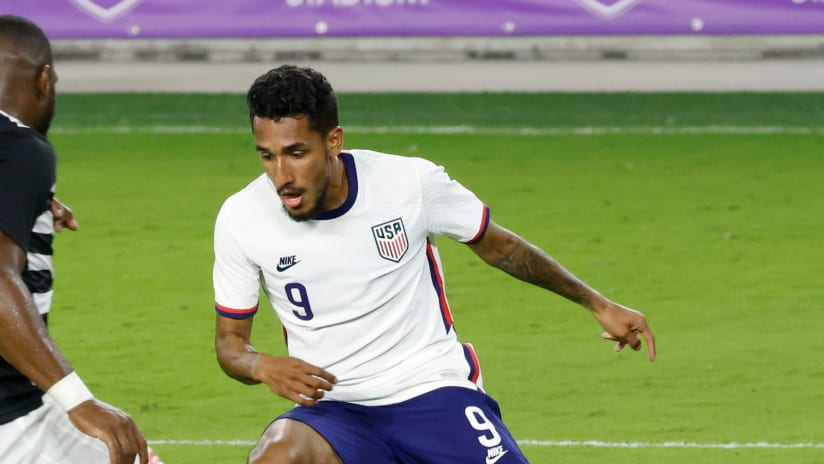The United States’ roster is set for this month’s Concacaf Olympic qualifying tournament in Guadalajara, and despite some prominent cuts from the squad, coach Jason Kreis believes that the 20-player group announced on Thursday can get the job done and end the program’s 12-year drought at the Summer Games.
“It's important for U.S. Soccer to continue to lay down markers – Under-17, Under-20, Under-23, we need to continue to lay down markers that we are a dominant team in this region,” said Kreis. “I do believe that this is an important moment for us to continue on that path, to continue to change people's opinions about our national team programs.”
That task officially starts vs. Costa Rica on March 18, followed by two more group-stage matches vs. the Dominican Republic and Mexico in short succession. The top two finishers move on to the all-important semifinal round, where it’s win and you’re into the Olympics. The smaller-than-usual roster size for this pressure-packed event poses a particular challenge and Kreis made clear that was a prime factor in his staff’s decisions.
“We've got fullbacks that can play center back, we've got right backs that can play on the left back, we've got an attacking midfielder, a number 8-minded player in Hassani Dotson who's played both right back and left back for Minnesota. We've got wingers that have played inside,” he said in a Thursday afternoon media availability. “So we feel like we've got enough versatility with this group that we should be able to put our best foot forward, no doubt.”
Some of the biggest questions swirl around central midfield, where the squad looks heavy on defensive-minded types and short on playmakers. But Kreis contends that’s mostly a matter of perception, using Dotson and his Brazilian-American counterpart Johnny Cardoso as examples of players who are capable of getting forward with more vim than their clubs typically allow them to.
“I feel we have a lot of guys that, in my humble opinion, are more 8s than they are necessarily 10s or 6s,” said Kreis. “And in the way that we are playing right now in the national teams programs, it's really good. We aren't going to necessarily have a player that has a free role to sit in a No. 10 spot. We need central midfielders that can do it all. And I feel like with this pool of guys that we've selected, they can all do it all.
“Maybe most people don't know this, but Johnny Cardoso was developed as a 9,” he added. “The couple of times we've had him in the national team camps, once with the 23s, once with the full team, the first time in the 23s I had him at 6 but then looked at him at 8 late in the camp and in the game. And he showed that he's got some real creative ideas in the attacking half of the field. So he's another player that I think is quite versatile.”
The US are expected to utilize the same sort of 4-3-3 formation that the full men’s national team has fielded in recent months, typically with a holding No. 6 backing twin No. 8s in central midfield. But all three players in the engine room will be expected to cover ground and protect the back line.
“I don't see us defending with one shield, I see us defending with three,” said Kreis. “That's what we really like about this defensive system is that we've got three guys in those positions that are going to be asked to be extremely mobile, to give us both sides of the ball and to move across the field together to cover all the spaces.”
Kreis hinted that FC Dallas homegrown Jesus Ferreira – who’s worked as more of a “false 9” on international duty – and RSL academy product Sebastian Soto are the leading contenders to lead the line up top.
“Jesus is an interesting one, probably the most interesting one, because he hasn't played a whole lot of striker for FC Dallas, they typically will use him in midfield,” said the former Real Salt Lake, NYCFC and Orlando City boss. “But the way that we want to utilize our 9 means that Jesus is a perfect candidate for that. And having Jesus in last January camp, and then having him again in this January camp, we see a player that really seems to understand and fit our game model in that position, and we see in his performance in the match, it was excellent, really, really excellent in the match against Trinidad [and Tobago].
“So he's a guy that that we are looking at that position. And then we have Sebastian Soto, another player that over the past four or five months with his full national team experience has taken advantage of his opportunity.”
He and his staff are also facing a tough call at goalkeeper, where San Jose’s JT Marcinkowski seems to have a narrow advantage on Philadelphia’s Matt Freese, with RSL’s David Ochoa also in the mix and platooning a real possibility.
“We have these three goalkeepers, we like all three, and we're kind of looking at them like OK, who can be the starter?” said Kreis. “I don't feel like anybody's really put that flag in the ground to say ‘I'm the guy.’ And so now we have to make, I think, a really difficult decision. And I think what we're probably thinking about is maybe one gets the first game and the other gets the second game, then based on that performance we move forward.”













